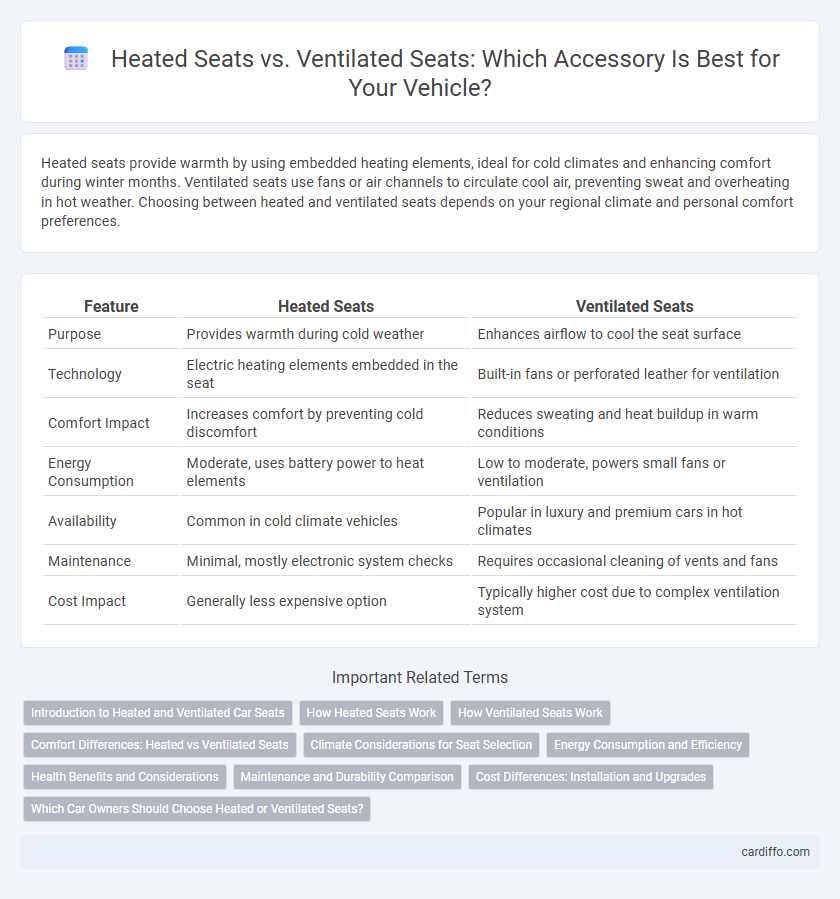Heated seats provide warmth by using embedded heating elements, ideal for cold climates and enhancing comfort during winter months. Ventilated seats use fans or air channels to circulate cool air, preventing sweat and overheating in hot weather. Choosing between heated and ventilated seats depends on your regional climate and personal comfort preferences.
Table of Comparison
| Feature | Heated Seats | Ventilated Seats |
|---|---|---|
| Purpose | Provides warmth during cold weather | Enhances airflow to cool the seat surface |
| Technology | Electric heating elements embedded in the seat | Built-in fans or perforated leather for ventilation |
| Comfort Impact | Increases comfort by preventing cold discomfort | Reduces sweating and heat buildup in warm conditions |
| Energy Consumption | Moderate, uses battery power to heat elements | Low to moderate, powers small fans or ventilation |
| Availability | Common in cold climate vehicles | Popular in luxury and premium cars in hot climates |
| Maintenance | Minimal, mostly electronic system checks | Requires occasional cleaning of vents and fans |
| Cost Impact | Generally less expensive option | Typically higher cost due to complex ventilation system |
Introduction to Heated and Ventilated Car Seats
Heated and ventilated car seats enhance driving comfort by regulating seat temperature according to weather conditions. Heated seats utilize built-in electric heating elements to provide warmth during cold weather, improving circulation and comfort. Ventilated seats feature integrated fans that circulate air to keep the driver and passengers cool and dry in hot or humid climates.
How Heated Seats Work
Heated seats use electrical heating elements embedded within the seat cushions to generate warmth quickly and efficiently, providing comfort during cold weather. These elements are controlled by a thermostat or sensor, which regulates the temperature to prevent overheating and ensure consistent heat distribution. Unlike ventilated seats that circulate air to cool the occupant, heated seats rely solely on radiant heat to create a cozy seating environment.
How Ventilated Seats Work
Ventilated seats use integrated fans or blowers to circulate air through perforated seat surfaces, effectively dissipating heat and moisture from the occupant's body. This ventilation system enhances comfort by maintaining a cooler seating environment, particularly in warm climates or during prolonged driving. Combining breathability with temperature regulation, ventilated seats help reduce sweating and improve overall passenger comfort.
Comfort Differences: Heated vs Ventilated Seats
Heated seats provide warmth by circulating heat through embedded heating elements, ideal for cold climates and improving comfort during winter months. Ventilated seats use fans and perforated upholstery to circulate air, reducing sweat and maintaining a cooler surface, perfect for hot and humid conditions. Comfort differences depend on climate preference, with heated seats enhancing warmth and ventilated seats offering breathability and moisture control.
Climate Considerations for Seat Selection
Heated seats provide optimal comfort in cold climates by quickly warming the seat surface to maintain body heat during winter months. Ventilated seats enhance comfort in hot and humid climates by circulating air through perforations, reducing sweat and overheating. Selecting between heated and ventilated seats depends on regional temperature patterns and personal climate preferences to ensure maximum driving comfort.
Energy Consumption and Efficiency
Heated seats typically consume more energy as they rely on resistive heating elements to generate warmth, leading to higher power draw from the vehicle's battery or electrical system. Ventilated seats use fans to circulate air, which generally requires less energy but offers effective cooling only under specific conditions. Evaluating energy consumption reveals that ventilated seats are more efficient in moderate climates, while heated seats demand greater energy, impacting overall vehicle efficiency.
Health Benefits and Considerations
Heated seats enhance blood circulation and alleviate muscle stiffness, particularly beneficial during cold weather or for individuals with arthritis. Ventilated seats improve comfort by reducing heat and moisture buildup, which helps prevent skin irritation and excessive sweating in hot climates. Choosing between these accessories depends on personal health needs and environmental conditions, ensuring optimal ergonomic support and comfort.
Maintenance and Durability Comparison
Heated seats require periodic inspection of electrical components and the heating elements to prevent malfunction, with wiring prone to wear over time due to heat stress. Ventilated seats involve maintenance of tiny fans and air channels that can accumulate dust and debris, potentially leading to reduced airflow and fan noise; these mechanical parts may have a shorter lifespan in comparison. Overall, heated seats tend to be more durable with fewer moving parts, while ventilated seats demand more frequent maintenance to ensure optimal performance.
Cost Differences: Installation and Upgrades
Heated seats typically incur lower installation costs compared to ventilated seats due to simpler heating elements and wiring requirements. Upgrading to ventilated seats demands more complex components such as fans and air channels, driving up both parts and labor expenses. Vehicle models with factory-installed climate control systems often reduce these costs by integrating seat upgrades more seamlessly.
Which Car Owners Should Choose Heated or Ventilated Seats?
Car owners in colder climates benefit significantly from heated seats, which provide warmth and comfort during winter months, enhancing driving experience and reducing the need for bulky clothing. Conversely, those residing in hot or humid regions should opt for ventilated seats, designed to circulate air and prevent sweating, promoting a cooler and more comfortable ride. Selecting seats based on local climate and personal comfort preferences ensures optimal cabin temperature control and long-term satisfaction.
Heated seats vs ventilated seats Infographic

 cardiffo.com
cardiffo.com